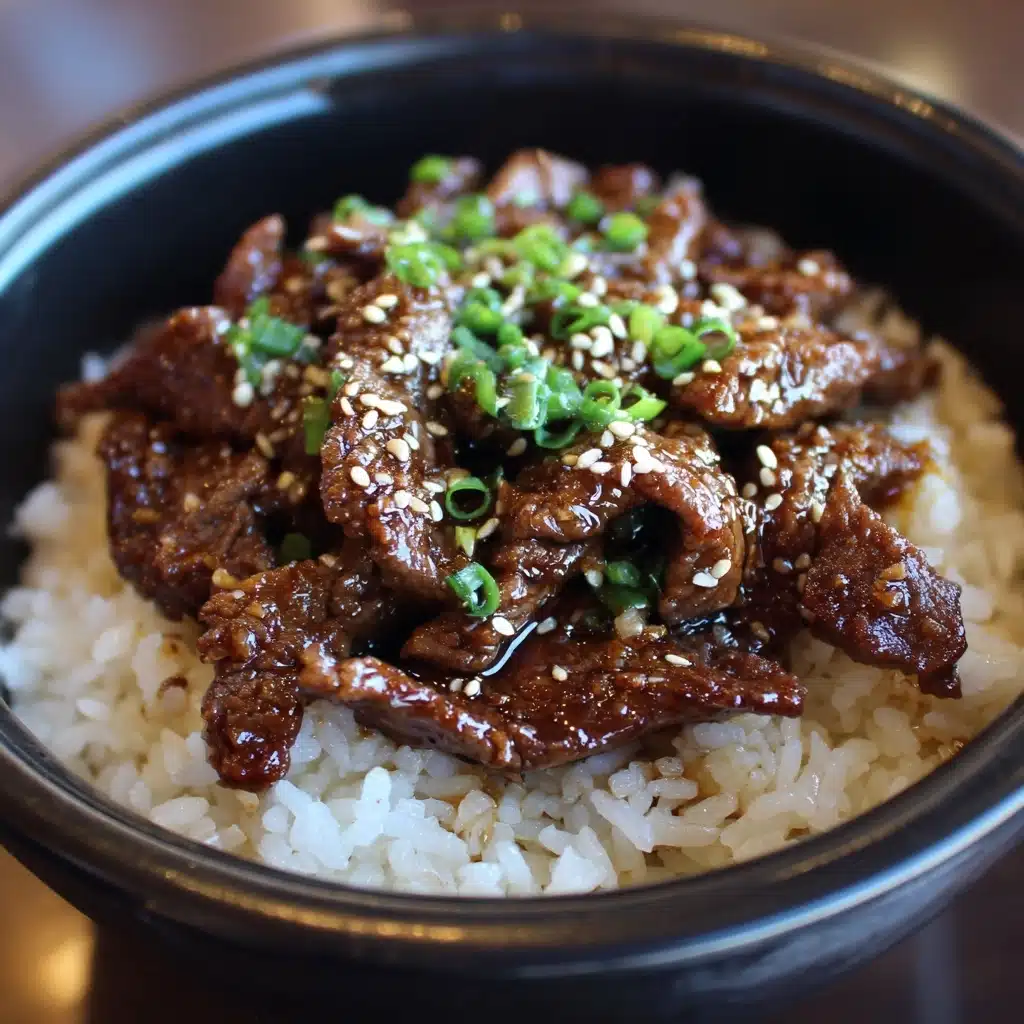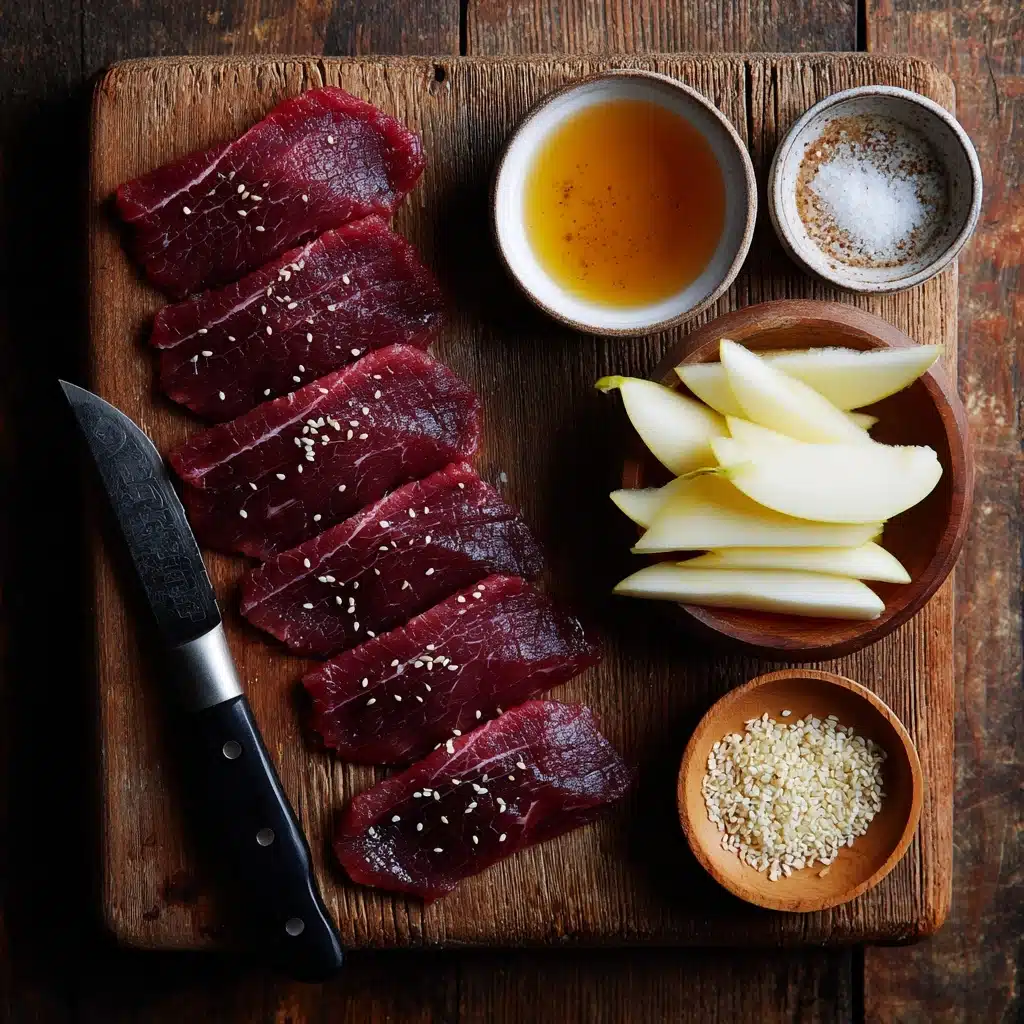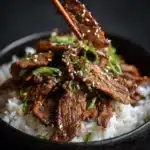Get ready to fall in love with the irresistible flavors and mouthwatering aroma of this Korean Beef Bulgogi Recipe. Tender strips of marinated beef are caramelized to perfection in a savory-sweet sauce, kissed with honey butter, and served alongside crisp veggies and fluffy rice. Every bite is the perfect balance of salty, sweet, and umami, making this dish a crowd-pleaser whether you’re new to Korean cooking or already a die-hard fan. It’s a true celebration on a plate and has quickly become a favorite in my kitchen for busy weeknights or fun gatherings with friends.

Ingredients You’ll Need
You’ll be amazed at how just a handful of simple, quality ingredients create the dazzling flavors in this Korean Beef Bulgogi Recipe. Each component brings something special—whether it’s juicy tenderness, a pop of color, deep umami, or that signature sweet-and-savory contrast Koreans are famous for.
- Ribeye or sirloin steak: Go for thinly sliced beef for ultimate tenderness; ribeye offers the most melt-in-your-mouth texture, but sirloin keeps things lighter.
- Soy sauce: This is the backbone of the marinade, lending savory depth and boldness.
- Brown sugar: Adds subtle sweetness and assists in the coveted beef caramelization.
- Sesame oil: A drizzle gives the marinade its signature toasty, nutty aroma.
- Garlic: Freshly minced for a pungent, unmistakable warmth.
- Fresh ginger: Grated ginger brings vibrancy and a gentle bite to the marinade.
- Asian pear or red apple: The secret tenderizer, grating it into the sauce ensures the beef stays soft and juicy.
- Mirin (optional): Adds a hint of sweetness and complexity if you have it on hand.
- Gochujang (optional): For a boost of heat and deep, smoky spice; totally customizable.
- Black pepper: A sprinkle sharpens all the flavors nicely.
- Green onions: Finely chopped, they brighten up the marinade and finish.
- Toasted sesame seeds: For little bursts of crunch and nuttiness.
- Neutral oil (for cooking): Keeps everything from sticking and lets the bulgogi flavors shine.
- Onion: Thinly sliced for sweetness and texture in the final dish.
- Carrot: Julienne strips add color, crunch, and a hint of earthiness.
- Mushrooms (shiitake or white button): They soak up the sauce and provide savory notes.
- Honey butter (1 tbsp melted butter + 1 tbsp honey): This is the magical finishing touch, elevating every bite to wow territory.
- Cooked rice: It’s not bulgogi night without the perfect bowl of hot steamed rice.
- Lettuce or perilla leaves: For wrapping, adding freshness and making each bite an interactive experience.
- Extra sesame seeds and sliced green onions: The final flourish of flavor and visual appeal.
How to Make Korean Beef Bulgogi Recipe
Step 1: Prepare the Beef
Start by placing your steak in the freezer for about 30 minutes—trust me, this makes it so much easier to slice nice and thin. With a sharp knife, cut against the grain into narrow strips; this ensures every bite is gloriously tender, not tough.
Step 2: Make the Marinade
Whisk together the soy sauce, brown sugar, sesame oil, garlic, ginger, grated Asian pear (or apple), mirin, gochujang, and black pepper in a big bowl. Add the green onions and sesame seeds last. The aroma at this stage will already have your taste buds tingling!
Step 3: Marinate the Beef
Toss the beef slices into that rich marinade, making sure every little strip gets coated. Cover and refrigerate for at least an hour, but if you can let it sit overnight, the Korean Beef Bulgogi Recipe will become positively addictive—the flavors soak right in!
Step 4: Prepare the Vegetables
While the beef soaks up all those flavors, take a moment to slice your onion, julienne the carrot, and slice up your mushrooms. Having everything ready makes cooking a breeze.
Step 5: Cook the Bulgogi
Heat a grill pan or cast iron skillet over medium-high and add a touch of oil. Spread the marinated beef in batches so the pan isn’t overcrowded—that’s the secret to caramelizing, not steaming! Sear for 2–3 minutes per side, and just as it’s finishing, drizzle on that honey butter and toss quickly. The glossy, golden meat that emerges is simply irresistible.
Step 6: Sauté the Vegetables
In the same glorious pan, add a bit more oil (if needed) and throw in the onions, carrots, and mushrooms. Give them a few minutes to soften and soak up any lingering marinade, winding up with beautifully tender, slightly sweet veggies.
Step 7: Serve
Pile the bulgogi beef and sautéed vegetables onto a serving platter. Scatter extra sesame seeds and green onions over the top for that restaurant-worthy touch. Spoon some over fluffy rice or wrap it up in lettuce or perilla leaves for the authentic Korean experience.
How to Serve Korean Beef Bulgogi Recipe

Garnishes
Sprinkle the finished dish with toasted sesame seeds and a generous scattering of sliced green onions. Not only is this traditional, but it guarantees every bite of this Korean Beef Bulgogi Recipe bursts with color, crunch, and pop.
Side Dishes
Classic accompaniments like kimchi, pickled radish, and a bowl of steamy rice round things out beautifully. If you’re feeling adventurous, add a side of japchae (Korean sweet potato noodles) or simple cucumber salad for a refreshing contrast.
Creative Ways to Present
Serve our Korean Beef Bulgogi Recipe DIY-style: set out bowls of rice, lettuce leaves, and little dishes of Sriracha or ssamjang so everyone can wrap and build their own bulgogi bites. It’s not only fun but encourages everyone to savor the flavors just the way they love most!
Make Ahead and Storage
Storing Leftovers
Once cooled, pack any leftover bulgogi and veggies into an airtight container and refrigerate. Enjoy it within 3-4 days for the best flavor and texture—the marinade actually deepens the taste as it sits!
Freezing
This Korean Beef Bulgogi Recipe freezes beautifully, making it perfect for meal prep. Portion the cooled cooked bulgogi (without the veggies if you wish) into freezer bags and store for up to 2 months. Thaw overnight in the fridge when ready to use.
Reheating
For best results, reheat gently in a skillet over medium heat, tossing just until warmed through. You can also microwave in 30-second bursts. Add a tiny splash of water or extra honey butter if the beef looks a bit dry.
FAQs
What cut of beef is best for this Korean Beef Bulgogi Recipe?
Ribeye is the gold standard for tenderness and fat marbling, but sirloin is a fantastic lean alternative. The most important thing is slicing the beef very thinly across the grain!
Can I make this recipe without Asian pear?
Absolutely! A red or even green apple is a great substitute. Both options lend natural sweetness and help tenderize the meat, so you won’t miss a thing.
Is there a vegetarian version of Korean Beef Bulgogi Recipe?
You can replicate the core flavors by using extra-firm tofu or sliced king oyster mushrooms marinated and sautéed in the same signature bulgogi sauce. It’s hearty, satisfying, and perfect for plant-based eaters.
Can I grill the beef instead of pan-frying?
Yes—preheat your grill to high heat, then cook the marinated beef slices directly on the grates or use a grill basket. You’ll get an extra smoky, flame-kissed flavor that’s absolutely divine.
How spicy is this Korean Beef Bulgogi Recipe?
It’s totally customizable! Gochujang and black pepper bring the heat, but you can dial them up or down based on your preference. Leave them out for a milder version everyone can enjoy.
Final Thoughts
I can’t say enough good things about this Korean Beef Bulgogi Recipe—it’s a joyful dish that always brings people together for seconds (and sometimes thirds). Give it a go, share it, and let the irresistible flavors speak for themselves. Happy cooking!
PrintKorean Beef Bulgogi Recipe
Bulgogi, which means “fire meat” in Korean, features thinly sliced beef marinated in a savory-sweet sauce, then grilled or pan-fried to caramelized perfection. This recipe includes all the traditional elements with a slight twist—a drizzle of honey butter during cooking to enhance caramelization and deepen the umami flavor.
- Prep Time: 15 minutes
- Cook Time: 10 minutes
- Total Time: 1 hour 25 minutes
- Yield: 4 servings
- Category: Main Course
- Method: Grilling or Pan-frying
- Cuisine: Korean
- Diet: Non-Vegetarian
Ingredients
For the Beef:
- 1.5 lbs ribeye or sirloin steak, thinly sliced against the grain
For the Marinade:
- 6 tbsp soy sauce
- 3 tbsp brown sugar
- 2 tbsp sesame oil
- 4 cloves garlic, minced
- 1 tbsp fresh ginger, grated
- 1/2 Asian pear or red apple, grated
- 2 tbsp mirin (optional)
- 1 tbsp gochujang (optional, for spice)
- 1/4 tsp black pepper
- 2 tbsp finely chopped green onions
- 1 tsp toasted sesame seeds
For Cooking & Serving:
- 1 tbsp neutral oil (for cooking)
- 1 small onion, thinly sliced
- 1 carrot, julienned
- 1 cup mushrooms (shiitake or white button), sliced
- 2 tbsp honey butter (1 tbsp melted butter + 1 tbsp honey, mixed)
- Cooked rice, for serving
- Lettuce leaves or perilla leaves, for wrapping
- Extra sesame seeds and sliced green onions, for garnish
Instructions
- Prepare the Beef: Place the beef in the freezer for 30 minutes to firm up, making it easier to slice. Use a sharp knife to cut it into thin strips against the grain.
- Make the Marinade: In a large bowl, whisk together soy sauce, brown sugar, sesame oil, garlic, ginger, grated pear or apple, mirin (if using), gochujang (if using), and black pepper. Stir in the chopped green onions and sesame seeds.
- Marinate the Beef: Add the sliced beef to the marinade, ensuring every piece is coated. Cover and refrigerate for at least 1 hour, or overnight for a deeper flavor.
- Prepare Vegetables: While the beef marinates, slice the onion, julienne the carrot, and cut the mushrooms.
- Cook the Bulgogi: Heat a grill pan or cast iron skillet over medium-high heat and add 1 tbsp oil. Add the marinated beef in batches to avoid overcrowding. Cook for 2–3 minutes per side until caramelized. Just before the beef finishes cooking, drizzle with the honey butter to enhance the caramelization. Toss quickly to coat. Remove from the pan and set aside.
- Sauté the Vegetables: In the same pan, add the sliced onion, carrot, and mushrooms. Sauté for 3–4 minutes until softened.
- Serve: Arrange the cooked beef and vegetables on a plate. Garnish with extra sesame seeds and green onions. Serve with steamed rice or wrap in lettuce/perilla leaves with kimchi on the side.
Notes
- Why the honey butter? This is the original twist—most recipes rely on sugar for sweetness, but honey butter adds an extra depth of caramelization while balancing the saltiness of the soy sauce. It also gives the meat a beautiful glaze.
- Meat selection: Ribeye is the most tender, but sirloin works well for a leaner option.
- Marination tip: The longer, the better! Overnight marination creates the most flavorful and tender beef.
- Spice level: Gochujang is optional but adds a nice kick. Adjust to taste.
- Cooking method: If using a grill, preheat to high heat and cook the beef directly on the grates for a smokier flavor.
Nutrition
- Serving Size: 1 serving
- Calories: 450 kcal
- Sugar: N/A
- Sodium: N/A
- Fat: 20g
- Saturated Fat: N/A
- Unsaturated Fat: N/A
- Trans Fat: N/A
- Carbohydrates: 30g
- Fiber: N/A
- Protein: 30g
- Cholesterol: N/A








